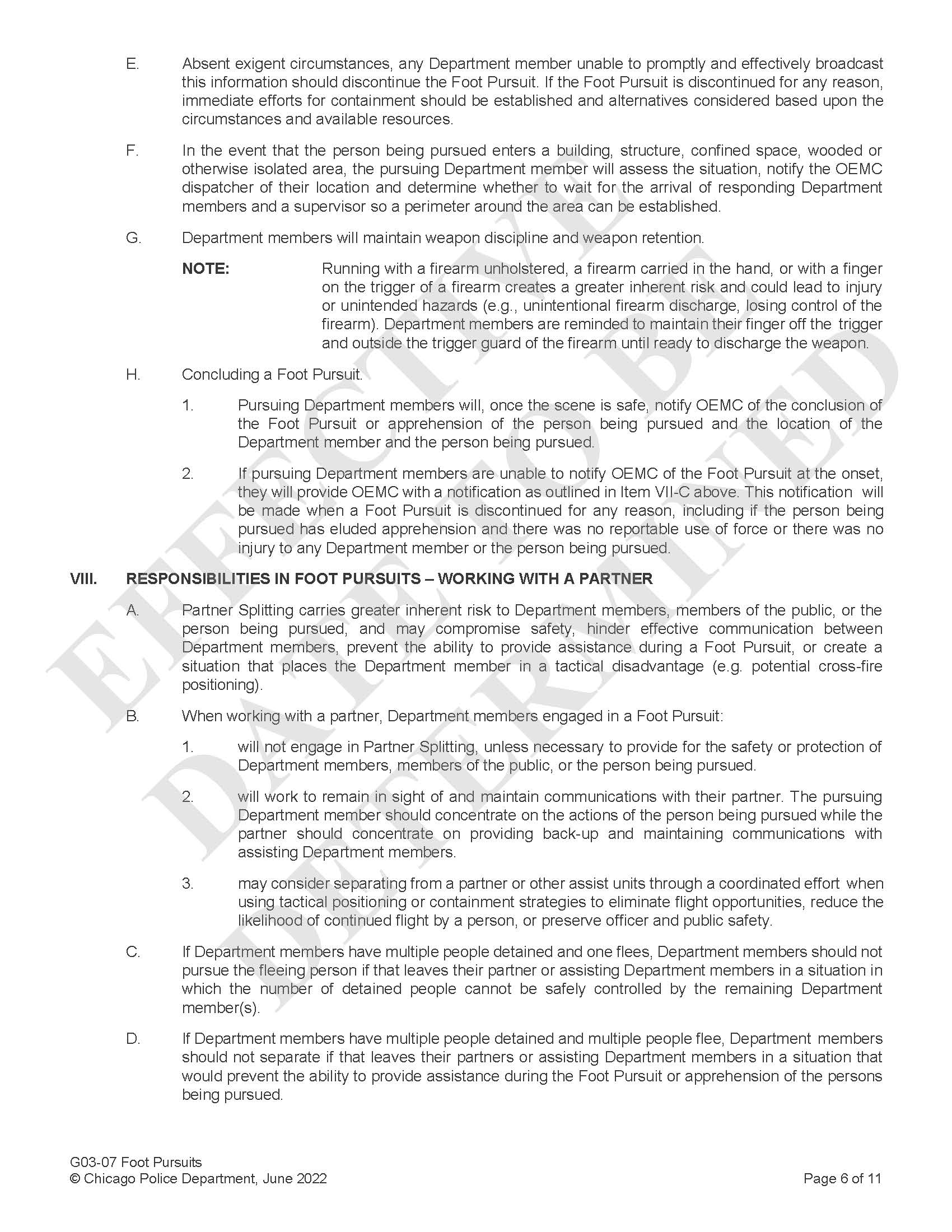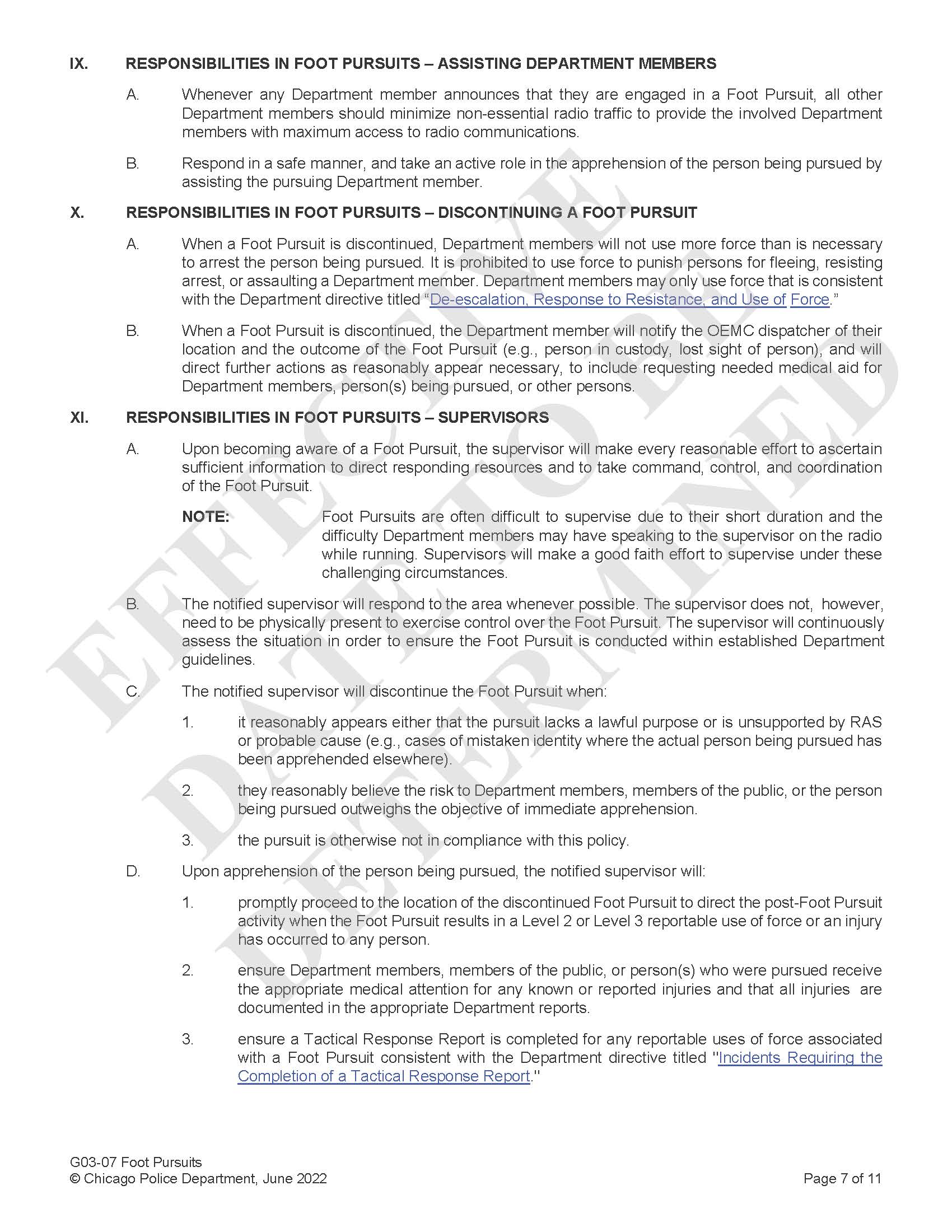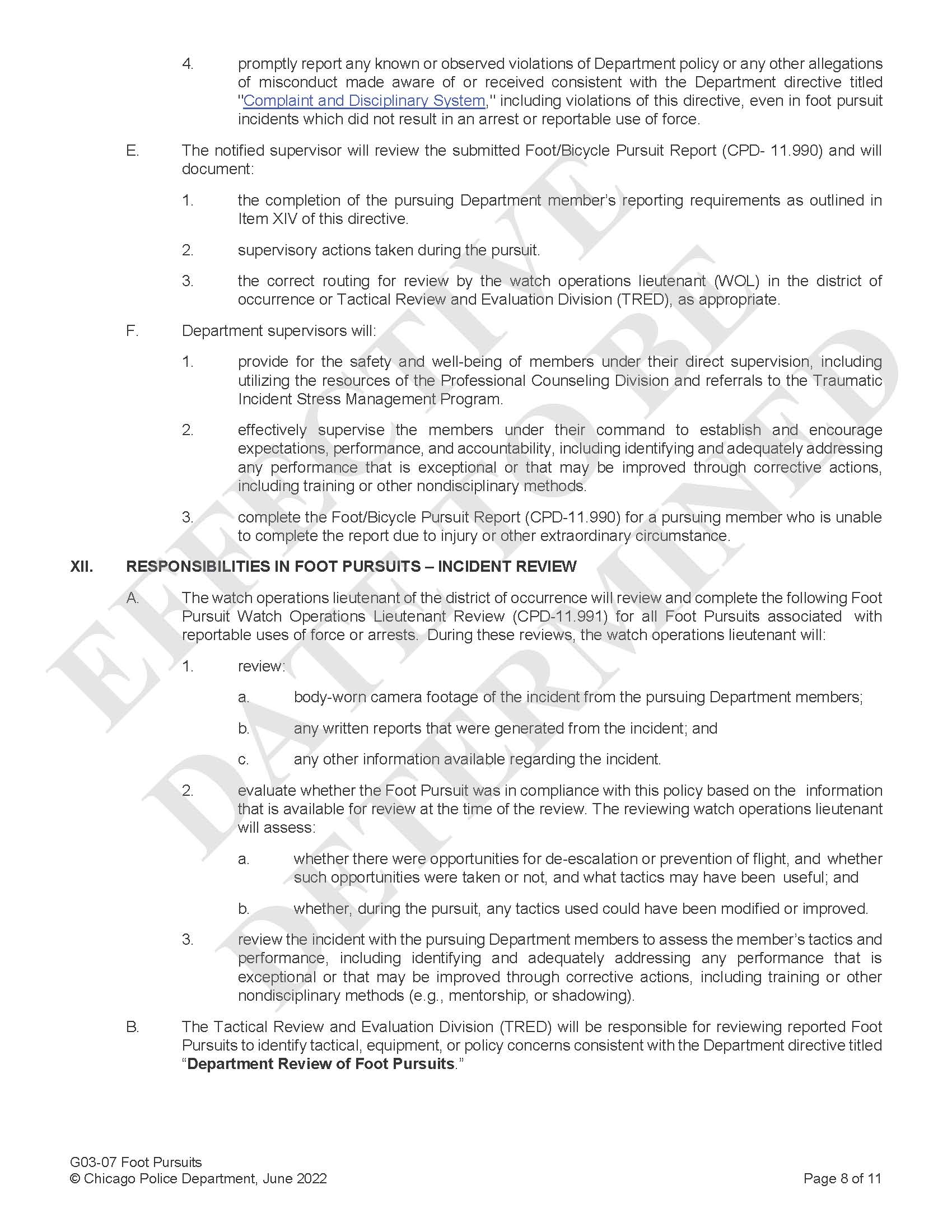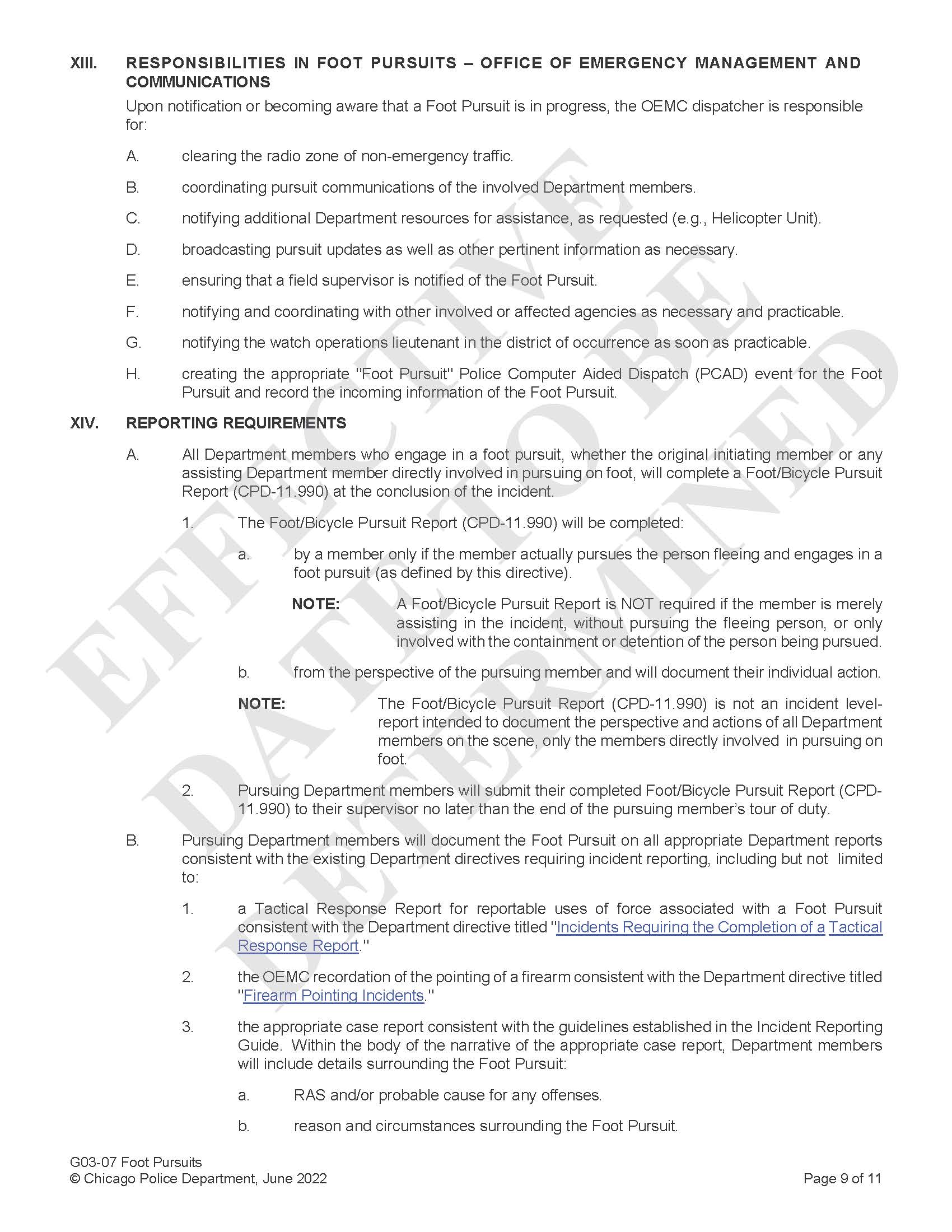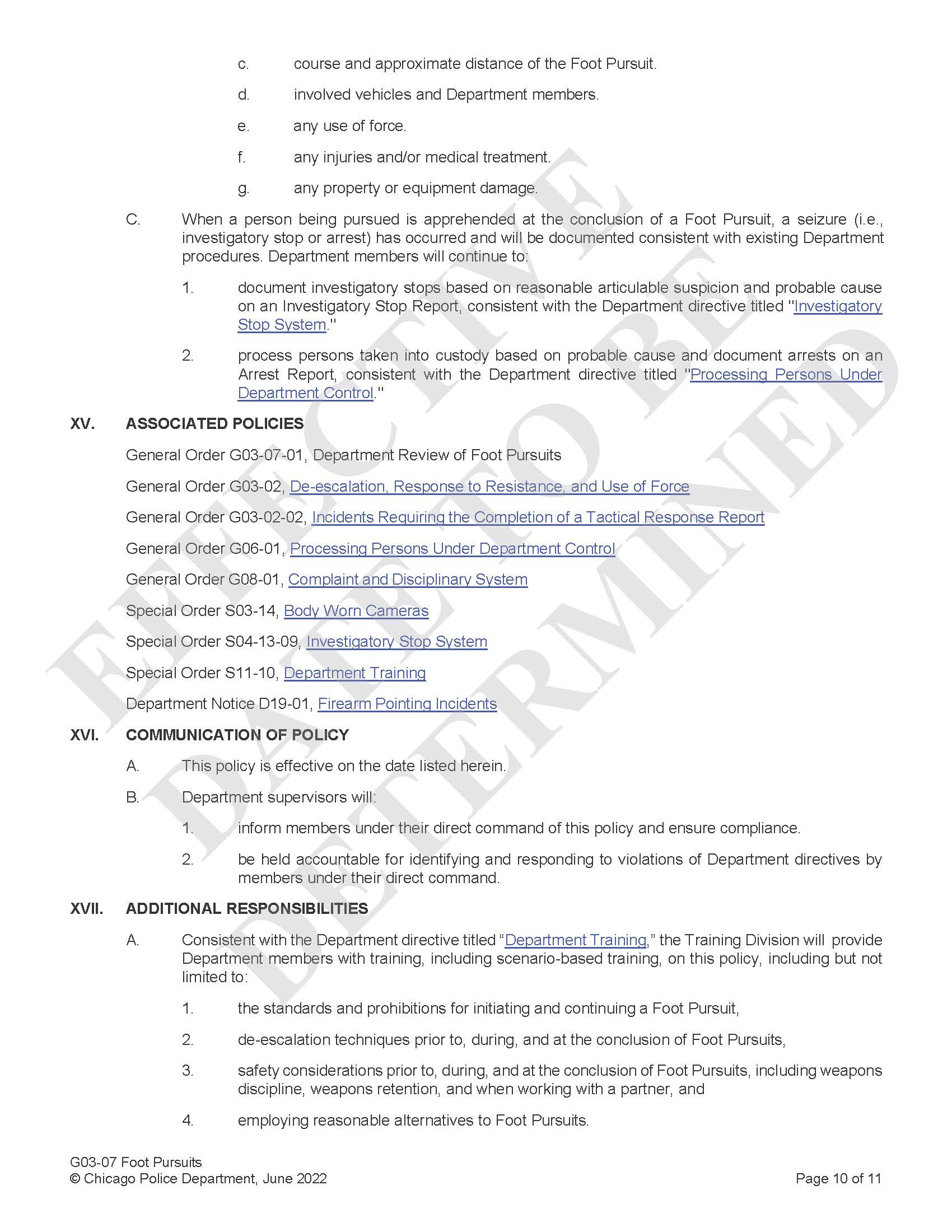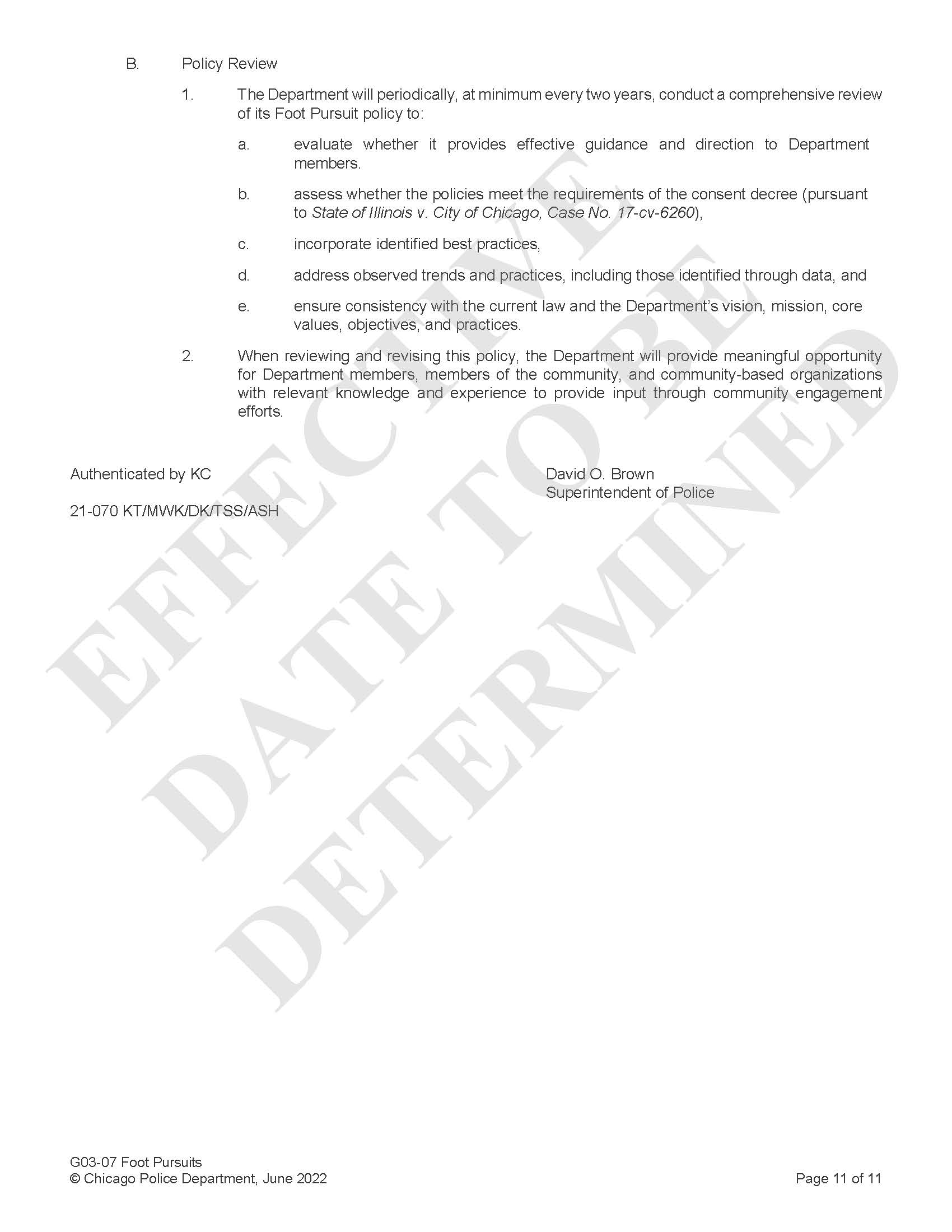Foot Pursuits - General Order G03-07
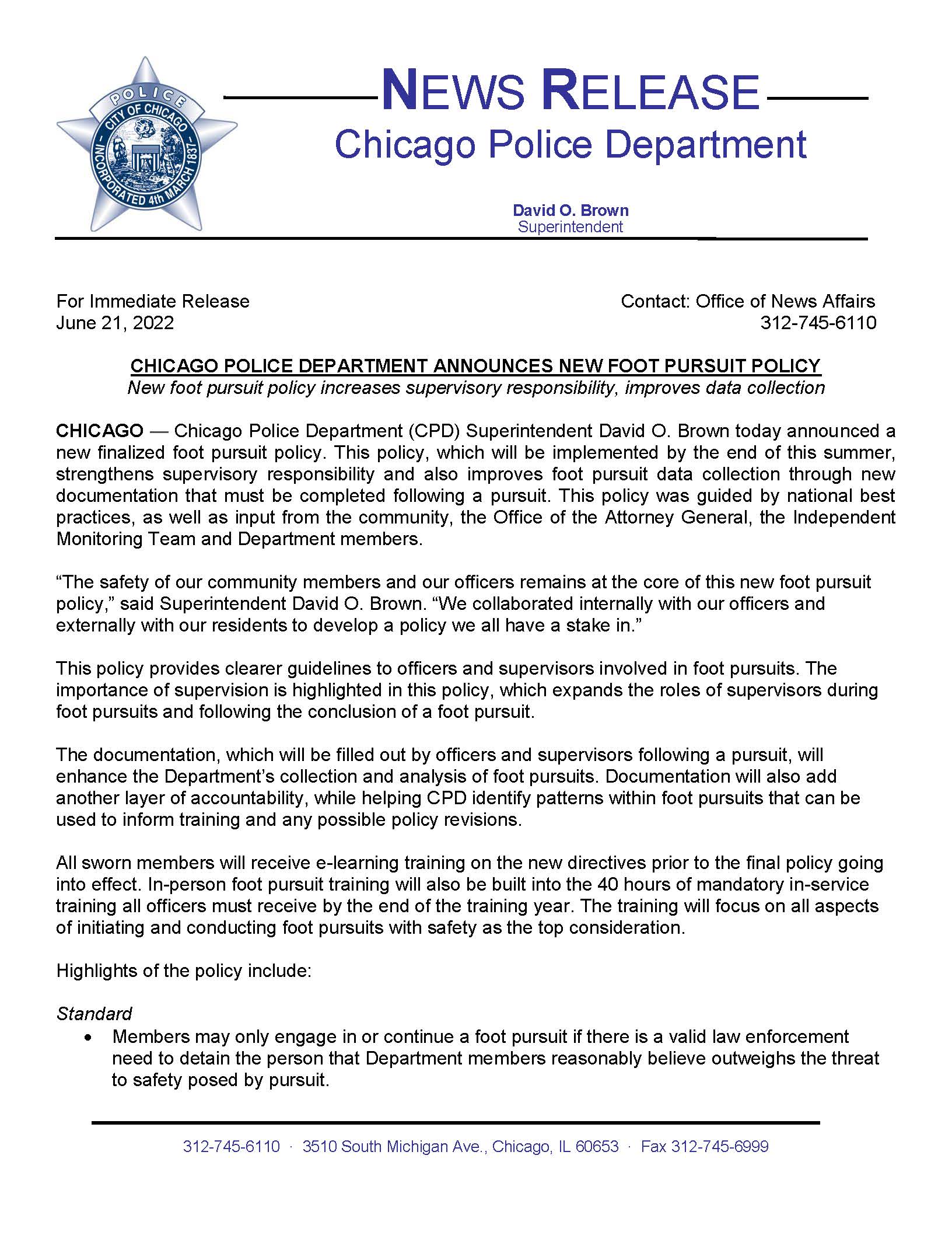
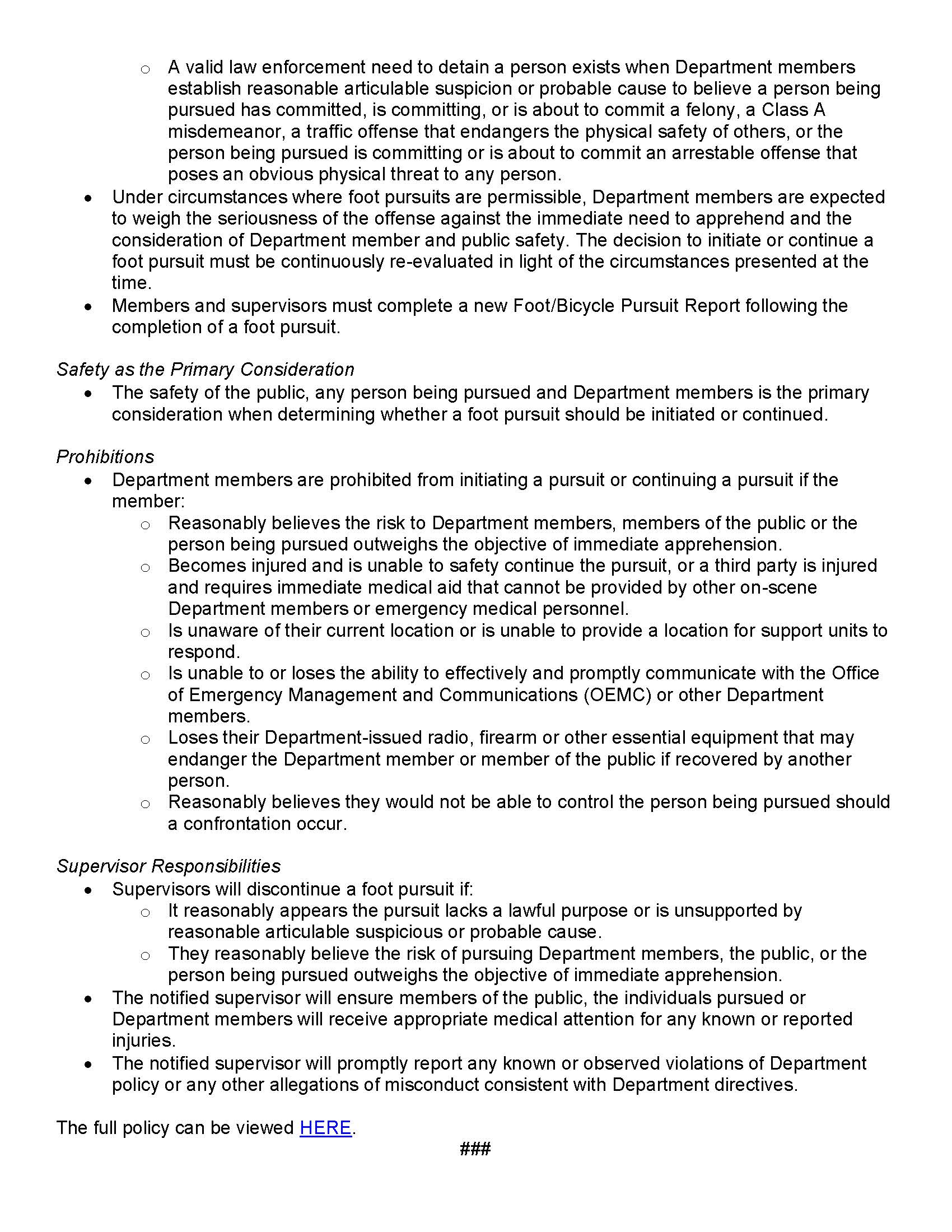 Chicago Police Department -- General Order G03-07
Chicago Police Department -- General Order G03-07
FOOT PURSUITS
ISSUE DATE: To Be Determined EFFECTIVE DATE: To Be Determined
RESCINDS: 11 June 2021 Version
INDEX CATEGORY: 03 - Field Operations
CALEA: CHICAGO POLICE DEPARTMENT ANNOUNCES NEW FOOT PURSUIT POLICY
New foot pursuit policy increases supervisory responsibility, improves data collection
CHICAGO — Chicago Police Department (CPD) Superintendent David O. Brown today announced a new finalized foot pursuit policy. This policy, which will be implemented by the end of this summer, strengthens supervisory responsibility and also improves foot pursuit data collection through new documentation that must be completed following a pursuit. This policy was guided by national best practices, as well as input from the community, the Office of the Attorney General, the Independent Monitoring Team and Department members.
“The safety of our community members and our officers remains at the core of this new foot pursuit policy,” said Superintendent David O. Brown. “We collaborated internally with our officers and
externally with our residents to develop a policy we all have a stake in.”
This policy provides clearer guidelines to officers and supervisors involved in foot pursuits. The importance of supervision is highlighted in this policy, which expands the roles of supervisors during foot pursuits and following the conclusion of a foot pursuit.
The documentation, which will be filled out by officers and supervisors following a pursuit, will enhance the Department’s collection and analysis of foot pursuits. Documentation will also add another layer of accountability, while helping CPD identify patterns within foot pursuits that can be used to inform training and any possible policy revisions.
All sworn members will receive e-learning training on the new directives prior to the final policy going into effect. In-person foot pursuit training will also be built into the 40 hours of mandatory in-service training all officers must receive by the end of the training year. The training will focus on all aspects of initiating and conducting foot pursuits with safety as the top consideration.
Highlights of the policy include:
Standard
• Members may only engage in or continue a foot pursuit if there is a valid law enforcement need to detain the person that Department members reasonably believe outweighs the threat to safety posed by pursuit.
o A valid law enforcement need to detain a person exists when Department members establish reasonable articulable suspicion or probable cause to believe a person being pursued has committed, is committing, or is about to commit a felony, a Class A misdemeanor, a traffic offense that endangers the physical safety of others, or the person being pursued is committing or is about to commit an arrestable offense that poses an obvious physical threat to any person.
• Under circumstances where foot pursuits are permissible, Department members are expected to weigh the seriousness of the offense against the immediate need to apprehend and the consideration of Department member and public safety. The decision to initiate or continue a foot pursuit must be continuously re-evaluated in light of the circumstances presented at the time.
• Members and supervisors must complete a new Foot/Bicycle Pursuit Report following the completion of a foot pursuit.
Safety as the Primary Consideration
• The safety of the public, any person being pursued and Department members is the primary consideration when determining whether a foot pursuit should be initiated or continued.
Prohibitions
• Department members are prohibited from initiating a pursuit or continuing a pursuit if the member:
o Reasonably believes the risk to Department members, members of the public or the person being pursued outweighs the objective of immediate apprehension.
o Becomes injured and is unable to safety continue the pursuit, or a third party is injured and requires immediate medical aid that cannot be provided by other on-scene Department members or emergency medical personnel.
o Is unaware of their current location or is unable to provide a location for support units to respond.
o Is unable to or loses the ability to effectively and promptly communicate with the Office of Emergency Management and Communications (OEMC) or other Department members.
o Loses their Department-issued radio, firearm or other essential equipment that may endanger the Department member or member of the public if recovered by another person.
o Reasonably believes they would not be able to control the person being pursued should a confrontation occur.
Supervisor Responsibilities
• Supervisors will discontinue a foot pursuit if:
o It reasonably appears the pursuit lacks a lawful purpose or is unsupported by reasonable articulable suspicious or probable cause.
o They reasonably believe the risk of pursuing Department members, the public, or the person being pursued outweighs the objective of immediate apprehension.
• The notified supervisor will ensure members of the public, the individuals pursued or Department members will receive appropriate medical attention for any known or reported injuries.
• The notified supervisor will promptly report any known or observed violations of Department policy or any other allegations of misconduct consistent with Department directives.
The full policy can be viewed HERE.
https://home.chicagopolice.org/reform/policy-review/revised-foot-pursuits-policy-draft/
----------------------
I. PURPOSE
This directive:
A. establishes Chicago Police Department (CPD) policy that Department members may engage in Foot Pursuits only when there is a valid law enforcement need to detain the person that the Department members reasonably believe outweighs the threat to safety posed by pursuit (except when otherwise specifically prohibited).
B. details the responsibilities for pursuing members, assisting members, and supervisors when involved in a Foot Pursuit and their responsibilities to safely apprehend persons being pursued.
C. introduces the Foot/Bicycle Pursuit Report [CPD-11.990 (5/22)].
D. introduces the Foot Pursuit Watch Operations Lieutenant Review [CPD-11.991 (5/22)].
II. CORE PRINCIPLES
A. Mission of the Chicago Police Department. The Department’s mission is “to serve our communities and protect the lives, rights, and property of all people in Chicago.” The CPD acts in a unified manner to uphold this mission.
B. Sanctity of Life. The Department’s highest priority is the sanctity of all human life. The concept of the sanctity of human life is the belief that all human beings are to be perceived and treated as persons of inherent worth and dignity, regardless of race, color, sex, gender identity, age, religion, disability, national origin, ancestry, sexual orientation, marital status, parental status, military status, immigration status, homeless status, source of income, credit history, criminal record, criminal history, or incarceration status. Department members must act with the foremost regard for the preservation of human life and the safety of all persons involved.
C. Justified Pursuits. The mere act of flight alone by a person will not serve as justification for engaging in a Foot Pursuit. Department members are prohibited from basing an investigatory stop solely on a person’s response to the presence of police, such as a person’s attempt to avoid contact with a Department member or flight.
D. Safety of Department Member, Community, and Person Being Pursued. The safety of Department members, members of the public, and any person being pursued is the primary consideration when determining whether a Foot Pursuit should be initiated or continued. Foot pursuits carry inherent risk to Department members, members of the public, and person(s) being pursued. Department members must act reasonably, based on the totality of the circumstances and must continuously balance the objective of apprehending the person(s) being pursued with the risk and potential for injury to Department members, members of the community, or the person(s) being pursued.
E. Supervision and Discontinuing of a Pursuit. The pursuing Department member will comply with the guidance and instructions given by a supervisor during a Foot Pursuit, including instructions to hold a position or discontinue a pursuit. When instructed to discontinue a Foot Pursuit or hold their position, Department members will safely end the pursuit and take a safe tactical position without unreasonably endangering themselves or others.
F. Use of Force. Department members must use the tactics described below to avoid the use of unnecessary or excessive force during or at the conclusion of a Foot Pursuit. When a Foot Pursuit is discontinued with a person in custody, Department members are prohibited from using force to punish persons for fleeing, resisting arrest, or assaulting a Department member.
III. DEFINITIONS
A. Foot Pursuit — When a Department member pursues (on foot or bicycle) a fleeing person who is attempting to evade detention by law enforcement for reasonable articulable suspicion RAS or probable cause that a person has committed, is committing, or is about to commit a crime.
B. Partner Splitting — When distance, obstacles, or loss of visual contact separates partners or other assisting Department members to the extent that it prevents the ability to provide assistance during a Foot Pursuit or the apprehension of the person being pursued.
C. Reasonable Articulable Suspicion (RAS) — A well-founded suspicion based on specific, objective, articulable facts, taken together with the Department member’s training and experience, that a person has committed, is committing, or is about to commit a crime.
D. Probable Cause – Where a Department member has knowledge of facts that would lead a reasonable person to believe that a crime has occurred and that the person has committed it. This differs from Reasonable Articulable Suspicion in that the facts supporting RAS do not need to meet probable cause requirements, but they must justify more than a mere hunch. The facts should not be viewed with analytical hindsight but instead should be considered from the perspective of a reasonable officer at the time that situation confronted him or her.
IV. DECISION TO PURSUE – DEPARTMENT MEMBER
A. Risks of Foot Pursuits. Foot pursuits carry inherent risk to Department members, members of the public, and persons being pursued and could be dangerous and lead to injury or unintended hazards.
1. The safety of Department members, members of the public, and any person being pursued is the primary consideration when determining whether a Foot Pursuit should be initiated or continued.
2. Based on safety as the primary consideration, Department members will be mindful that the safest response may be reasonable alternatives to engaging in or continuing a Foot Pursuit to apprehend the person being pursued, such as the use of tactical and technological apprehension efforts.
B. Department members may only engage in or continue a Foot Pursuit if there is a valid law enforcement need to detain the person that Department members reasonably believe outweighs the threat to safety posed by pursuit (except when otherwise specifically prohibited under Item V, Prohibitions, of this directive).
1. A valid law enforcement need to detain a person exists when the Department members establish RAS or probable cause to believe that (1) the person being pursued has committed, is committing, or is about to commit a Felony, a Class A misdemeanor, a traffic offense that endangers the physical safety of others, or (2) the person being pursued is committing or is about to commit an arrestable offense that poses an obvious physical threat to any person.
EXAMPLE: Some examples of Class A misdemeanor offenses where Foot Pursuits are permitted include aggravated assault, battery, domestic battery, unlawful use of weapon, criminal trespass to residence, theft, and retail theft.
Some examples of less than a Class A misdemeanor offenses where Foot Pursuits are prohibited include business license offenses, parking violations, ordinance violations (e.g., curfew drinking on the public way), or Class B or C misdemeanors (e.g., simple assault or criminal trespass to land).
EXAMPLE: Some examples of traffic offenses that endanger the physical safety of others where Foot Pursuits are permitted include driving under the influence, reckless driving, and street racing.
Some examples of traffic offenses where Foot Pursuits are prohibited include licensing violations (e.g., fictitious, altered, suspended, revoked, or unlawful use of license), insurance violations, and other petty violations enforceable by citation only.
2. Under circumstances where Foot Pursuits are permissible, Department members are expected to weigh the seriousness of the offense against the immediate need to apprehend and the consideration of Department member and public safety. The decision to initiate or continue such a Foot Pursuit must be continuously re-evaluated in light of the circumstances presented at the time.
C. A Department member may not conduct a Foot Pursuit based solely on a person’s response to the presence of police, including a person’s attempt to avoid contact with a Department member (e.g., walking away, declining to talk, running away, or crossing the street to avoid contact). People may avoid contact with a Department member for many reasons other than involvement in criminal activity.
D. Department members are prohibited from intentionally provoking or attempting to provoke flight in an effort to justify an Investigative Stop or a Foot Pursuit. For example, a Department member may not drive at a high rate of speed toward a group congregated on a corner, perform a threshold brake, and exit quickly with the intention of stopping anyone in the group who flees.
E. Deciding to initiate or continue a Foot Pursuit is a decision that a Department member must make quickly and under unpredictable and dynamic circumstances. It is recognized that Foot Pursuits may place Department members and the public at significant risk.
1. Any doubt by participating Department members or their supervisors regarding the overall safety of any Foot Pursuit shall be decided in favor of communication, coordination, surveillance, and containment.
2. Therefore, no Department member or supervisor will be criticized by another Department member or disciplined by the Department for deciding not to engage in a Foot Pursuit or for ordering an ongoing pursuit to be discontinued based upon a reasonable assessment of the perceived risk to the Department member and those they are entrusted to serve.
F. Because of the inherent risks involved in Foot Pursuits, the most appropriate tactical option to safely apprehend a fleeing person will differ in every circumstance. When determining the most appropriate tactical option, the safety of Department members, members of the public, and any person being pursued is the primary consideration.
G. In deciding whether to initiate or continue a Foot Pursuit, Department members should continuously consider reasonable alternatives based upon the circumstances and resources available, such as:
1. Containment of the area.
2. Saturation of the area with law enforcement personnel, including assistance from other agencies.
3. Video, monitoring, and apprehension technology.
4. Helicopter Unit support.
5. Apprehension at another time when the identity of the person being pursued is known or there is information available that would likely allow for later apprehension, and the need to immediately apprehend the person being pursued does not reasonably appear to outweigh the risk of continuing the Foot Pursuit.
V. PROHIBITIONS
Department members will not initiate or continue a Foot Pursuit if the Department member:
A. reasonably believes the risk to Department members, members of the public, or the person being pursued outweighs the objective of immediate apprehension.
B. becomes injured and is unable to safely continue the Foot Pursuit or a third party is injured and requires immediate medical aid that cannot be provided by other on-scene Department members or emergency medical personnel.
C. is unaware of their current location or is unable to provide a location for support units to respond.
D. is unable to or loses the ability to effectively and promptly communicate with OEMC or other Department members.
E. loses their Department-issued radio, their firearm, or other essential equipment that may endanger the Department member or the public if recovered by another person.
F. reasonably believes they would not be able to control the person being pursued should a confrontation occur (e.g., due to exhaustion or physical condition).
G. is directed by a supervisor not to initiate or continue a Foot Pursuit.
VI. PURSUIT GUIDELINES
Department members should consider alternatives to engaging in or continuing a Foot Pursuit in the following circumstances. These circumstances create particularly high risk for the Department members and the public.
A. The Department member is acting alone.
NOTE: A Department member should not initiate or continue a Foot Pursuit if acting alone and the pursuit results in a Department member chasing two or more people simultaneously.
B. The person being pursued is visibly armed with a firearm.
C. Two or more Department members become separated, lose visual contact with one another, or obstacles separate them to the extent that it prevents the ability to provide assistance during a Foot Pursuit or the apprehension of the person being pursued. In such circumstances, it is generally recommended that a single Department member keep the person being pursued in sight from a safe distance and coordinate the containment effort.
D. The person being pursued enters a building, structure, confined space, isolated area, or dense or difficult terrain, and there are insufficient Department members to provide backup and containment. The primary Department member should consider discontinuing the Foot Pursuit and coordinating containment pending the arrival of sufficient resources.
E. The Department member becomes aware of unanticipated circumstances that unreasonably increase the risk to Department members or the public.
F. The location of the person being pursued is no longer known.
G. The identity of the person being pursued is established or other information exists that will allow for the person being pursued apprehension at a later time, and it reasonably appears that there is no immediate threat to Department members or the public if the person being pursued is not immediately apprehended.
H. The Department member's ability to safely continue the Foot Pursuit is impaired by inclement weather, darkness, or other environmental conditions, such as steep terrain, worn-out structures, piles of debris, etc.
I. The presence of vehicular traffic in the area of the pursuit and risk of emergency vehicle response by additional Department members create safety concerns.
J. When the Department members involved are not readily identifiable as Chicago Police Officers.
NOTE: When Department members are not readily identifiable as Chicago Police Officers, the risk of harm from a Foot Pursuit increases because of possible confusion by the person being pursued, by members of the public, or by other Department members. Examples of when Department members are readily identifiable as Chicago Police Officers include, but are not limited to:
(1) being attired in a Class A, B, or C uniform; or
(2) being attired in casual dress with an overshirt carrier that displays the star and nameplate (including embroidered insignia), or working in a marked Department vehicle.
VII. RESPONSIBILITIES IN FOOT PURSUITS – THE PURSUING DEPARTMENT MEMBERS
A. Consistent with the Department directive titled "Body Worn Cameras," Department members will:
1. activate their body-worn camera to event mode at the beginning of an incident to record law- enforcement-related activities as outlined in the Illinois Officer-Worn Camera Act (50 ILCS 706/10).
2. continue to record the incident with their body-worn camera when initiating and engaging in a Foot Pursuit to ensure the entire pursuit is recorded.
3. indicate if the incident was recorded in any reports completed for the Foot Pursuit.
NOTE: If Department members have not yet activated their body-worn camera before initiating a Foot Pursuit, they must immediately activate their body-worn camera and ensure that the body-worn camera is activated throughout the duration of the Foot Pursuit.
B. Unless relieved by another Department member or a supervisor, the pursuing Department member will be responsible for coordinating the progress of the pursuit and containment. When acting alone and when practicable, the pursuing Department member should not attempt to overtake and confront the person being pursued but should attempt to keep the person being pursued in sight until sufficient Department members are present to safely apprehend the person being pursued.
C. Early communication of available information is essential. Upon engaging in a Foot Pursuit, the pursuing Department member will:
1. immediately, or as soon as safely practical, notify the Office of Emergency Management and Communications (OEMC) of a Foot Pursuit and broadcast the Department member's:
a. radio ID/beat number,
b. location, and
c. reason for the pursuit.
2. make reasonable efforts to provide OEMC with additional information and updates during the pursuit, including:
a. the direction of travel of the person being pursued and pursuing Department member.
b. whether the person being pursued is believed to be armed.
c. the person’s physical description or other identifiers.
d. the number of persons being pursued.
D. Department members should be mindful that radio transmissions made while running may be difficult to understand and may need to be repeated.
E. Absent exigent circumstances, any Department member unable to promptly and effectively broadcast this information should discontinue the Foot Pursuit. If the Foot Pursuit is discontinued for any reason, immediate efforts for containment should be established and alternatives considered based upon the circumstances and available resources.
F. In the event that the person being pursued enters a building, structure, confined space, wooded or otherwise isolated area, the pursuing Department member will assess the situation, notify the OEMC dispatcher of their location and determine whether to wait for the arrival of responding Department members and a supervisor so a perimeter around the area can be established.
G. Department members will maintain weapon discipline and weapon retention.
NOTE: Running with a firearm unholstered, a firearm carried in the hand, or with a finger on the trigger of a firearm creates a greater inherent risk and could lead to injury or unintended hazards (e.g., unintentional firearm discharge, losing control of the firearm). Department members are reminded to maintain their finger off the trigger and outside the trigger guard of the firearm until ready to discharge the weapon.
H. Concluding a Foot Pursuit.
1. Pursuing Department members will, once the scene is safe, notify OEMC of the conclusion of the Foot Pursuit or apprehension of the person being pursued and the location of the Department member and the person being pursued.
2. If pursuing Department members are unable to notify OEMC of the Foot Pursuit at the onset, they will provide OEMC with a notification as outlined in Item VII-C above. This notification will be made when a Foot Pursuit is discontinued for any reason, including if the person being pursued has eluded apprehension and there was no reportable use of force or there was no injury to any Department member or the person being pursued.
VIII. RESPONSIBILITIES IN FOOT PURSUITS – WORKING WITH A PARTNER
A. Partner Splitting carries greater inherent risk to Department members, members of the public, or the person being pursued, and may compromise safety, hinder effective communication between Department members, prevent the ability to provide assistance during a Foot Pursuit, or create a situation that places the Department member in a tactical disadvantage (e.g. potential cross-fire positioning).
B. When working with a partner, Department members engaged in a Foot Pursuit:
1. will not engage in Partner Splitting, unless necessary to provide for the safety or protection of Department members, members of the public, or the person being pursued.
2. will work to remain in sight of and maintain communications with their partner. The pursuing Department member should concentrate on the actions of the person being pursued while the partner should concentrate on providing back-up and maintaining communications with assisting Department members.
3. may consider separating from a partner or other assist units through a coordinated effort when using tactical positioning or containment strategies to eliminate flight opportunities, reduce the likelihood of continued flight by a person, or preserve officer and public safety.
C. If Department members have multiple people detained and one flees, Department members should not pursue the fleeing person if that leaves their partner or assisting Department members in a situation in which the number of detained people cannot be safely controlled by the remaining Department member(s).
D. If Department members have multiple people detained and multiple people flee, Department members should not separate if that leaves their partners or assisting Department members in a situation that would prevent the ability to provide assistance during the Foot Pursuit or apprehension of the persons being pursued.
IX. RESPONSIBILITIES IN FOOT PURSUITS – ASSISTING DEPARTMENT MEMBERS
A. Whenever any Department member announces that they are engaged in a Foot Pursuit, all other Department members should minimize non-essential radio traffic to provide the involved Department members with maximum access to radio communications.
B. Respond in a safe manner, and take an active role in the apprehension of the person being pursued by assisting the pursuing Department member.
X. RESPONSIBILITIES IN FOOT PURSUITS – DISCONTINUING A FOOT PURSUIT
A. When a Foot Pursuit is discontinued, Department members will not use more force than is necessary to arrest the person being pursued. It is prohibited to use force to punish persons for fleeing, resisting arrest, or assaulting a Department member. Department members may only use force that is consistent with the Department directive titled “De-escalation, Response to Resistance, and Use of Force.”
B. When a Foot Pursuit is discontinued, the Department member will notify the OEMC dispatcher of their location and the outcome of the Foot Pursuit (e.g., person in custody, lost sight of person), and will direct further actions as reasonably appear necessary, to include requesting needed medical aid for Department members, person(s) being pursued, or other persons.
XI. RESPONSIBILITIES IN FOOT PURSUITS – SUPERVISORS
A. Upon becoming aware of a Foot Pursuit, the supervisor will make every reasonable effort to ascertain sufficient information to direct responding resources and to take command, control, and coordination of the Foot Pursuit.
NOTE: Foot Pursuits are often difficult to supervise due to their short duration and the difficulty Department members may have speaking to the supervisor on the radio while running. Supervisors will make a good faith effort to supervise under these challenging circumstances.
B. The notified supervisor will respond to the area whenever possible. The supervisor does not, however, need to be physically present to exercise control over the Foot Pursuit. The supervisor will continuously assess the situation in order to ensure the Foot Pursuit is conducted within established Department guidelines.
C. The notified supervisor will discontinue the Foot Pursuit when:
1. it reasonably appears either that the pursuit lacks a lawful purpose or is unsupported by RAS or probable cause (e.g., cases of mistaken identity where the actual person being pursued has been apprehended elsewhere).
2. they reasonably believe the risk to Department members, members of the public, or the person being pursued outweighs the objective of immediate apprehension.
3. the pursuit is otherwise not in compliance with this policy.
D. Upon apprehension of the person being pursued, the notified supervisor will:
1. promptly proceed to the location of the discontinued Foot Pursuit to direct the post-Foot Pursuit activity when the Foot Pursuit results in a Level 2 or Level 3 reportable use of force or an injury has occurred to any person.
2. ensure Department members, members of the public, or person(s) who were pursued receive the appropriate medical attention for any known or reported injuries and that all injuries are documented in the appropriate Department reports.
3. ensure a Tactical Response Report is completed for any reportable uses of force associated with a Foot Pursuit consistent with the Department directive titled "Incidents Requiring the Completion of a Tactical Response Report."
4. promptly report any known or observed violations of Department policy or any other allegations of misconduct made aware of or received consistent with the Department directive titled "Complaint and Disciplinary System," including violations of this directive, even in foot pursuit incidents which did not result in an arrest or reportable use of force.
E. The notified supervisor will review the submitted Foot/Bicycle Pursuit Report (CPD- 11.990) and will document:
1. the completion of the pursuing Department member’s reporting requirements as outlined in Item XIV of this directive.
2. supervisory actions taken during the pursuit.
3. the correct routing for review by the watch operations lieutenant (WOL) in the district of occurrence or Tactical Review and Evaluation Division (TRED), as appropriate.
F. Department supervisors will:
1. provide for the safety and well-being of members under their direct supervision, including utilizing the resources of the Professional Counseling Division and referrals to the Traumatic Incident Stress Management Program.
2. effectively supervise the members under their command to establish and encourage expectations, performance, and accountability, including identifying and adequately addressing any performance that is exceptional or that may be improved through corrective actions, including training or other nondisciplinary methods.
3. complete the Foot/Bicycle Pursuit Report (CPD-11.990) for a pursuing member who is unable to complete the report due to injury or other extraordinary circumstance.
XII. RESPONSIBILITIES IN FOOT PURSUITS – INCIDENT REVIEW
A. The watch operations lieutenant of the district of occurrence will review and complete the following Foot Pursuit Watch Operations Lieutenant Review (CPD-11.991) for all Foot Pursuits associated with reportable uses of force or arrests. During these reviews, the watch operations lieutenant will:
1. review:
a. body-worn camera footage of the incident from the pursuing Department members;
b. any written reports that were generated from the incident; and
c. any other information available regarding the incident.
2. evaluate whether the Foot Pursuit was in compliance with this policy based on the information that is available for review at the time of the review. The reviewing watch operations lieutenant will assess:
a. whether there were opportunities for de-escalation or prevention of flight, and whether such opportunities were taken or not, and what tactics may have been useful; and
b. whether, during the pursuit, any tactics used could have been modified or improved.
3. review the incident with the pursuing Department members to assess the member’s tactics and performance, including identifying and adequately addressing any performance that is exceptional or that may be improved through corrective actions, including training or other nondisciplinary methods (e.g., mentorship, or shadowing).
B. The Tactical Review and Evaluation Division (TRED) will be responsible for reviewing reported Foot Pursuits to identify tactical, equipment, or policy concerns consistent with the Department directive titled “Department Review of Foot Pursuits.”
XIII. RESPONSIBILITIES IN FOOT PURSUITS – OFFICE OF EMERGENCY MANAGEMENT AND COMMUNICATIONS
Upon notification or becoming aware that a Foot Pursuit is in progress, the OEMC dispatcher is responsible for:
A. clearing the radio zone of non-emergency traffic.
B. coordinating pursuit communications of the involved Department members.
C. notifying additional Department resources for assistance, as requested (e.g., Helicopter Unit).
D. broadcasting pursuit updates as well as other pertinent information as necessary.
E. ensuring that a field supervisor is notified of the Foot Pursuit.
F. notifying and coordinating with other involved or affected agencies as necessary and practicable.
G. notifying the watch operations lieutenant in the district of occurrence as soon as practicable.
H. creating the appropriate "Foot Pursuit" Police Computer Aided Dispatch (PCAD) event for the Foot Pursuit and record the incoming information of the Foot Pursuit.
XIV. REPORTING REQUIREMENTS
A. All Department members who engage in a foot pursuit, whether the original initiating member or any assisting Department member directly involved in pursuing on foot, will complete a Foot/Bicycle Pursuit Report (CPD-11.990) at the conclusion of the incident.
1. The Foot/Bicycle Pursuit Report (CPD-11.990) will be completed:
a. by a member only if the member actually pursues the person fleeing and engages in a foot pursuit (as defined by this directive).
NOTE: A Foot/Bicycle Pursuit Report is NOT required if the member is merely assisting in the incident, without pursuing the fleeing person, or only involved with the containment or detention of the person being pursued.
b. from the perspective of the pursuing member and will document their individual action.
NOTE: The Foot/Bicycle Pursuit Report (CPD-11.990) is not an incident level- report intended to document the perspective and actions of all Department members on the scene, only the members directly involved in pursuing on foot.
2. Pursuing Department members will submit their completed Foot/Bicycle Pursuit Report (CPD- 11.990) to their supervisor no later than the end of the pursuing member’s tour of duty.
B. Pursuing Department members will document the Foot Pursuit on all appropriate Department reports consistent with the existing Department directives requiring incident reporting, including but not limited to:
1. a Tactical Response Report for reportable uses of force associated with a Foot Pursuit consistent with the Department directive titled "Incidents Requiring the Completion of a Tactical Response Report."
2. the OEMC recordation of the pointing of a firearm consistent with the Department directive titled "Firearm Pointing Incidents."
3. the appropriate case report consistent with the guidelines established in the Incident Reporting Guide. Within the body of the narrative of the appropriate case report, Department members will include details surrounding the Foot Pursuit:
a. RAS and/or probable cause for any offenses.
b. reason and circumstances surrounding the Foot Pursuit.
c. course and approximate distance of the Foot Pursuit.
d. involved vehicles and Department members.
e. any use of force.
f. any injuries and/or medical treatment.
g. any property or equipment damage.
C. When a person being pursued is apprehended at the conclusion of a Foot Pursuit, a seizure (i.e., investigatory stop or arrest) has occurred and will be documented consistent with existing Department procedures. Department members will continue to:
1. document investigatory stops based on reasonable articulable suspicion and probable cause on an Investigatory Stop Report, consistent with the Department directive titled "Investigatory Stop System."
2. process persons taken into custody based on probable cause and document arrests on an Arrest Report, consistent with the Department directive titled "Processing Persons Under Department Control."
XV. ASSOCIATED POLICIES
General Order G03-07-01, Department Review of Foot Pursuits
General Order G03-02, De-escalation, Response to Resistance, and Use of Force
General Order G03-02-02, Incidents Requiring the Completion of a Tactical Response Report General Order G06-01, Processing Persons Under Department Control
General Order G08-01, Complaint and Disciplinary System Special Order S03-14, Body Worn Cameras
Special Order S04-13-09, Investigatory Stop System Special Order S11-10, Department Training Department Notice D19-01, Firearm Pointing Incidents
XVI. COMMUNICATION OF POLICY
A. This policy is effective on the date listed herein.
B. Department supervisors will:
1. inform members under their direct command of this policy and ensure compliance.
2. be held accountable for identifying and responding to violations of Department directives by members under their direct command.
XVII. ADDITIONAL RESPONSIBILITIES
A. Consistent with the Department directive titled “Department Training,” the Training Division will provide Department members with training, including scenario-based training, on this policy, including but not limited to:
1. the standards and prohibitions for initiating and continuing a Foot Pursuit,
2. de-escalation techniques prior to, during, and at the conclusion of Foot Pursuits,
3. safety considerations prior to, during, and at the conclusion of Foot Pursuits, including weapons discipline, weapons retention, and when working with a partner, and
4. employing reasonable alternatives to Foot Pursuits.
B. Policy Review
1. The Department will periodically, at minimum every two years, conduct a comprehensive review of its Foot Pursuit policy to:
a. evaluate whether it provides effective guidance and direction to Department members.
b. assess whether the policies meet the requirements of the consent decree (pursuant to State of Illinois v. City of Chicago, Case No. 17-cv-6260),
c. incorporate identified best practices,
d. address observed trends and practices, including those identified through data, and
e. ensure consistency with the current law and the Department’s vision, mission, core values, objectives, and practices.
2. When reviewing and revising this policy, the Department will provide meaningful opportunity for Department members, members of the community, and community-based organizations with relevant knowledge and experience to provide input through community engagement efforts.
Authenticated by KC David O. Brown
Superintendent of Police
21-070 KT/MWK/DK/TSS/ASH
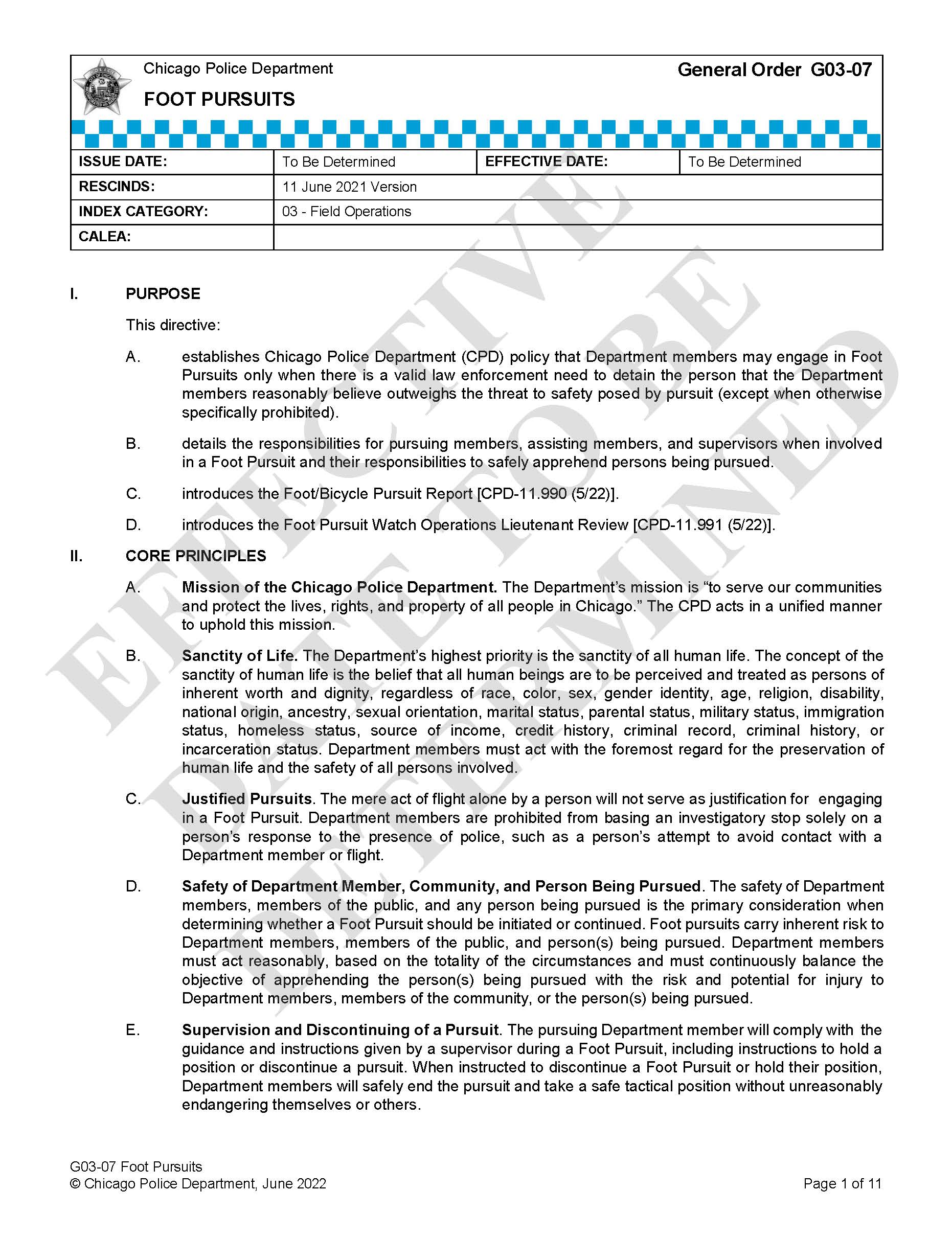
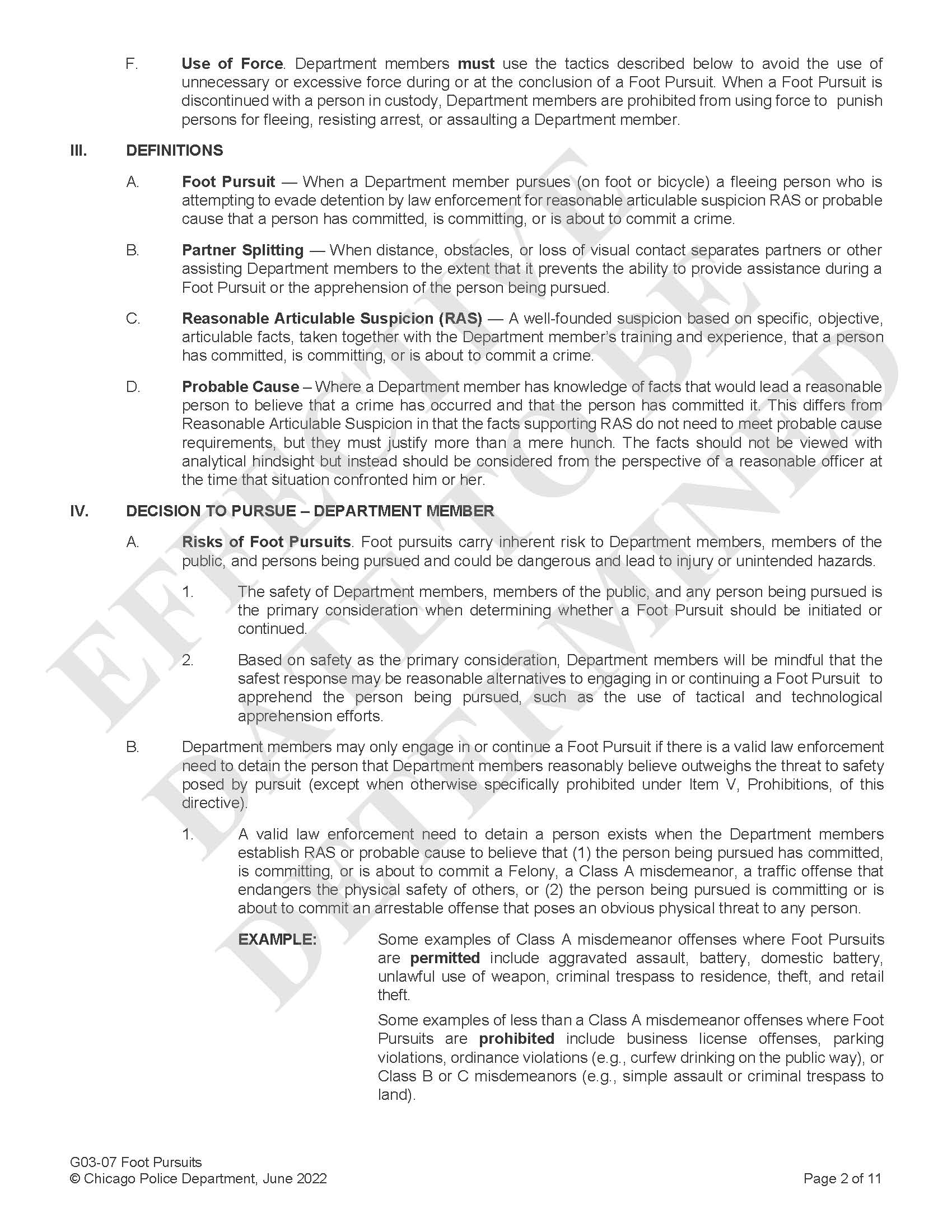
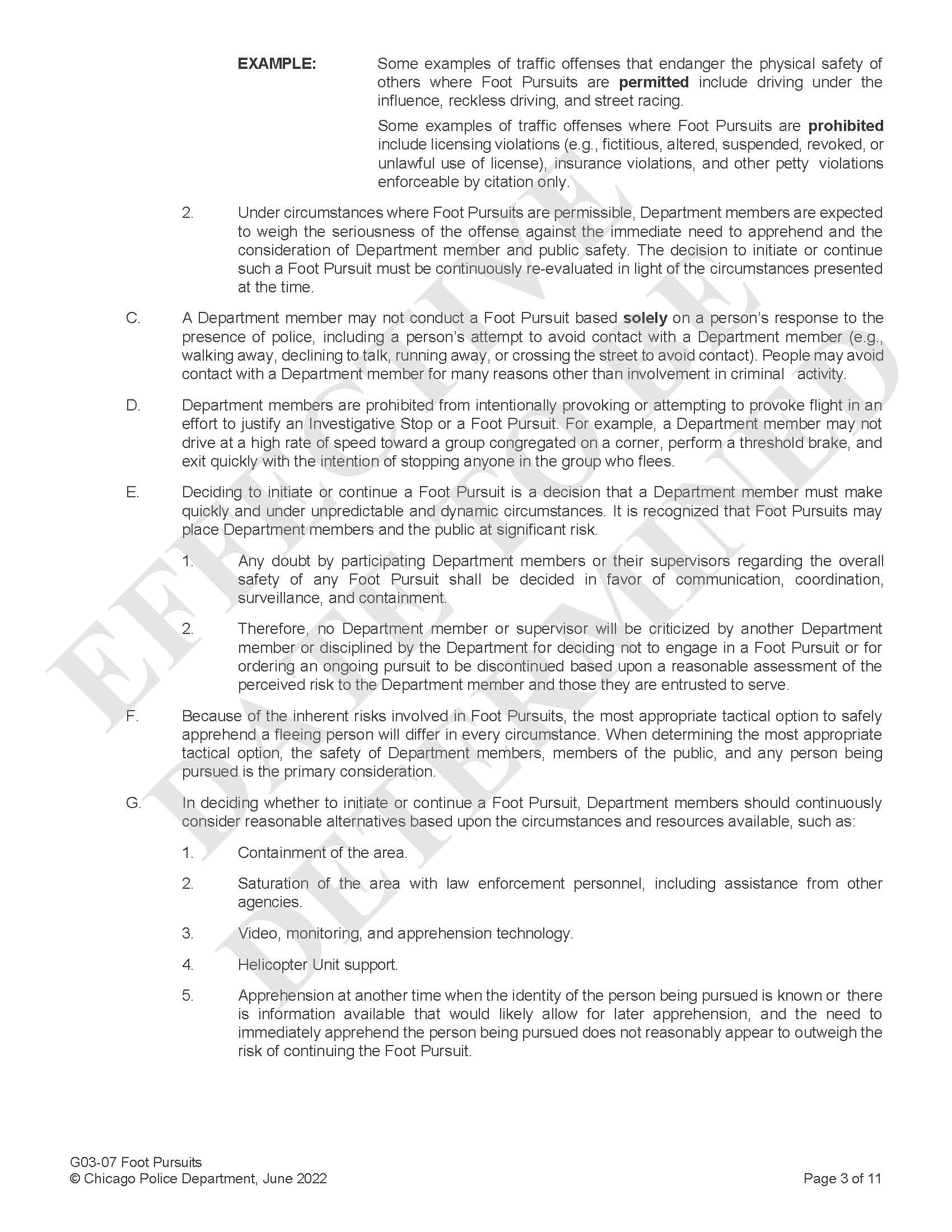 [img=117891]
[img=117891]
